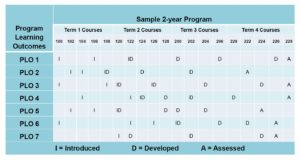
Author: Carolyn Ives
What is curriculum mapping?
Broadly, curriculum mapping is a process used to visualize and document relationships among curricular elements, such as course and program outcomes (NILOA, 2018). The most common use of curriculum mapping is to determine where within a program of study students might be achieving program-level learning outcomes (PLOs). A curriculum map is most typically presented as a grid or matrix that includes program-level learning outcomes along one axis and courses within the program along the other, but curriculum maps may take different forms or include different curricular elements as well (Stiehl & Lewchuk, 2005; Harden, 2001).
Why might a department or program want to create a curriculum map?
A department or program may undertake curriculum mapping for many reasons:
- To determine where PLO topics are being introduced, reinforced or developed, and assessed within a program;
- To determine gaps or redundancies within the curriculum;
- To assess program scaffolding or course sequencing to ensure it makes sense for student learning;
- To determine whether courses fit the PLOs within a program;
- To determine whether programs are addressing outcomes required by accreditation bodies; and
- To demonstrate transparency and communicability of the curriculum to stakeholders.
Different institutions create different kinds of curriculum maps, but they have similarities. The most common curriculum maps consist of a table within which PLOs are listed on one axis and program courses on the other, sometimes including required courses outside of the program as well. Faculty members—ideally those who are teaching the courses being mapped, as they understand the courses and context (Allen, 2004)—then go through each course systematically to see if any PLO is introduced, reinforced or developed, or assessed in that course.
A sample curriculum map for a two-year diploma program is included below:

Alternatively, curriculum maps might use different terminology, such as R = Reinforced, E = Emphasized (or Evaluated), or M = Mastered, depending on the program and its needs.
Some programs include required courses outside of their programs within their maps, as well as experiential courses such as labs, fieldwork, clinical placements, service learning, internships, and co-op. Maps can be as general or as specific as is helpful for the program. Some professional programs create multiple maps to analyze the curriculum from several vantage points. The various maps are used to demonstrate and explain when, how and what is taught and in what ways it is assessed (Harden, 2001).
If your map includes many courses, the axes may be reversed, as in the example below:

It's worth noting that few curriculum maps end up being as clean and aligned as the examples provided. A completed curriculum map can reveal much about a program’s strengths, gaps and course sequencing. Once visualized in the map(s), any deficiencies can be directly addressed and lead to curricular improvements or new curricular developments.
Programs sometimes create curriculum maps to determine whether external accreditation body requirements or institutional learning outcomes (ILOs) are being met. Instead of including PLOs on one of the axes, they may include the accreditation body’s required outcomes or the ILOs.
Curriculum mapping can happen at any level of curriculum for a variety of purposes. For example, a faculty member can map curriculum within a single course to ensure constructive alignment within a course (to ensure course-level learning outcomes, learning activities and instructional strategies, and assessments align), or it can happen at the institutional level to ensure all programs align with the ILOs.
The National Institute for Learning Outcomes Assessment (NILOA) has created a Mapping Toolkit to help faculty with curriculum mapping: https://www.learningoutcomesassessment.org/ourwork/curriculum-mapping/
Resources
Allen, M. J. (2004). Assessing academic programs in higher education. San Francisco, CA: Anker/Jossey-Bass.
Harden, R.M. (2001). AMEE guide no. 21: Curriculum mapping: a tool for transparent and authentic teaching and learning. Medical Teacher, 23:123-37. Retrieved from http://kipublications.ki.se/Default.aspx?queryparsed=id:134142710
National Institute for Learning Outcomes Assessment. (2018, March). Mapping learning: A toolkit of resources. Urbana, IL: University of Illinois at Urbana-Champaign, National Institute for Learning Outcomes Assessment (NILOA). Retrieved from https://www.learningoutcomesassessment.org/wp-content/uploads/2019/02/MappingLearning.pdf.
Stiehl, R., & Lewchuk, L. (2005). The mapping primer: Tools for reconstructing the college curriculum. Corvallis, Oregon: The Learning Organization.
************************************************************************************************

This work is licensed under a Creative Commons Attribution 4.0 International License.

